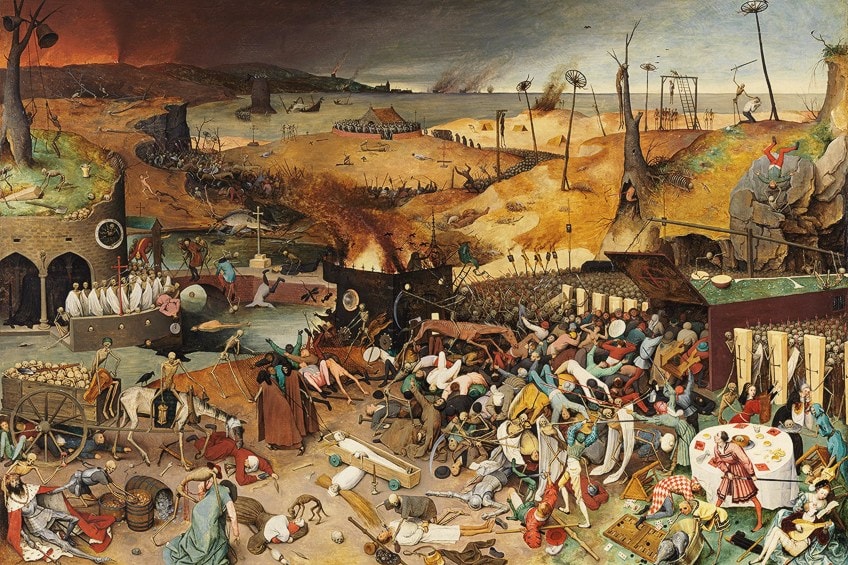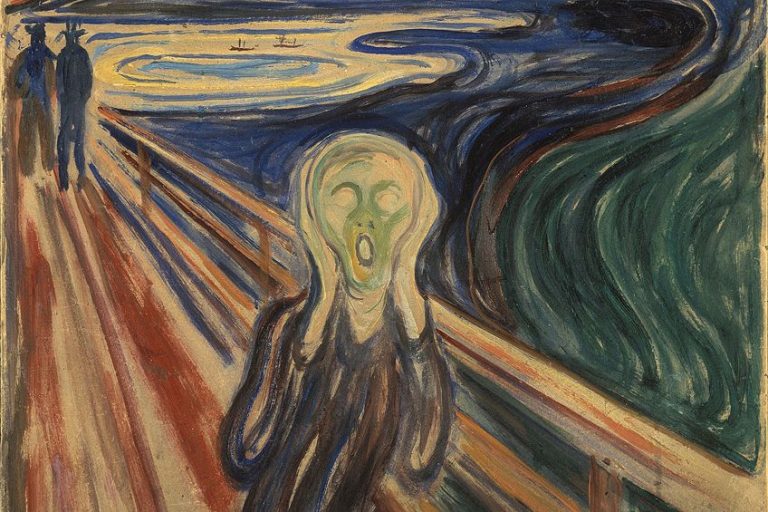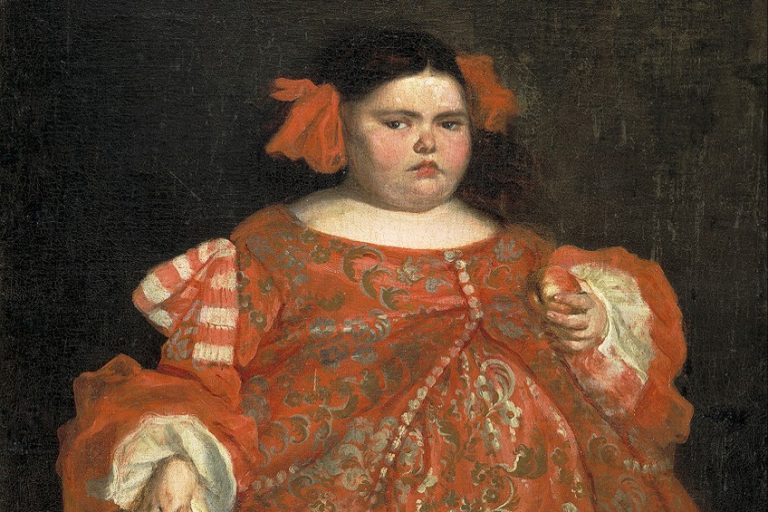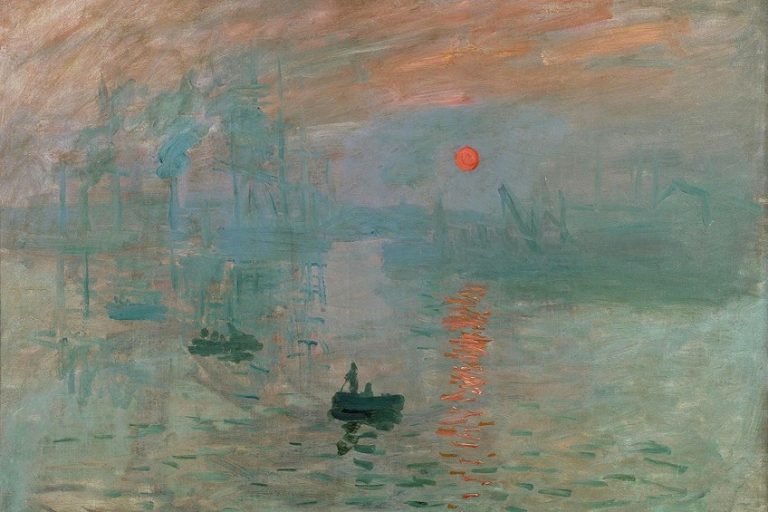“The Triumph of Death” by Pieter Bruegel the Elder – Art Analysis
Imagine a scene of carnage, death, pillaging, and plundering, all done by an army of skeletons. At first, you might laugh at the idea, but the idea comes to life in The Triumph of Death (c. 1562) by Pieter Bruegel the Elder, which is the painting we will discuss in this article.
Artist Abstract: Who Was Pieter Bruegel the Elder?
Pieter Bruegel the Elder was a Northern Renaissance artist; he was believed to be born in the Netherlands in a city called Breda or somewhere nearby. His date of birth is estimated to have been between 1525 and 1530.
He painted mythological and Biblical subject matter, but he became known for painting everyday people, usually peasants, and vast landscapes.
He was believed to apprentice for Pieter Coecke van Aelst and became part of the Guild of St. Luke of Antwerp. His death has been dated as September 9, 1569, although it is not certain how he died. Some of his famous paintings include The Tower of Babel (1563) and The Hunters in the Snow (1565), as well as The Peasant Wedding (1566-1569).
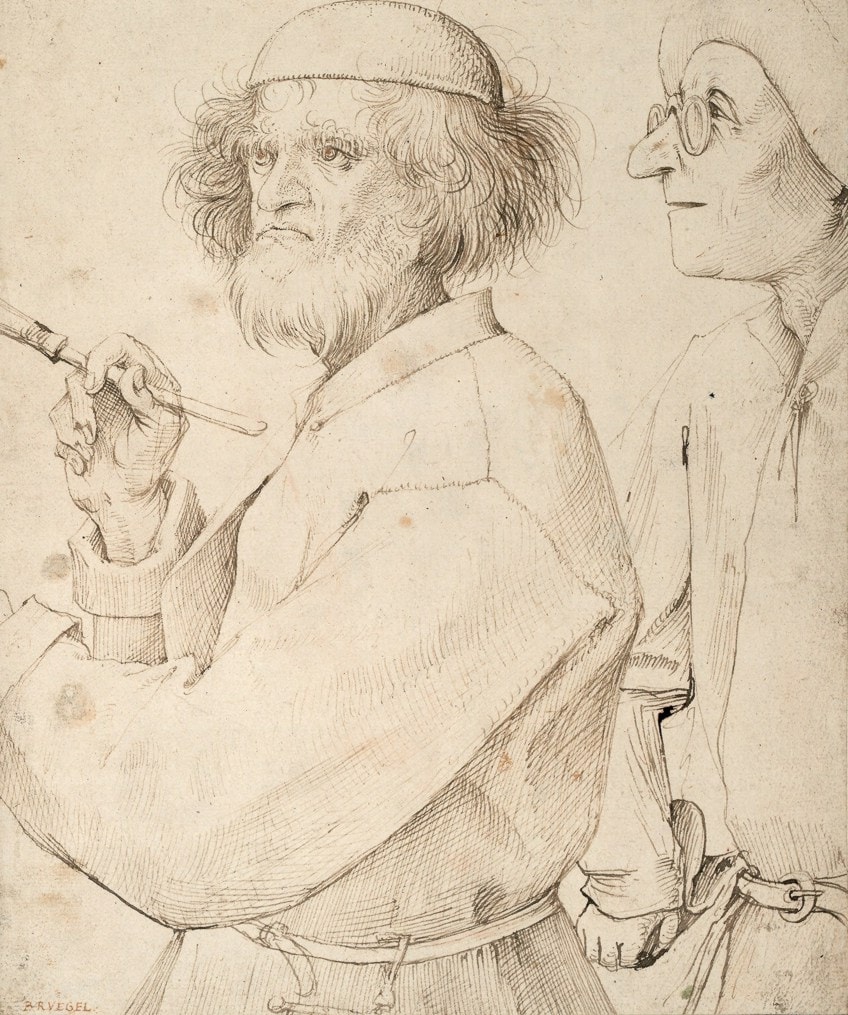
The Triumph of Death (c. 1562) by Pieter Bruegel the Elder in Context
The Triumph of Death by Pieter Bruegel the Elder is one of many of the Dutch painter’s landscape scenes filled with figures, but what exactly is this composition about? Below we will provide a socio-historical overview, briefly discussing the Northern Renaissance period and what influenced the subject matter. This will be followed by a formal analysis, looking at the subject matter as well as the artist’s stylistic approach.
| Artist | Pieter Bruegel the Elder |
| Date Painted | c. 1562 |
| Medium | Oil on panel |
| Genre | Genre painting |
| Period / Movement | Northern Renaissance (Dutch) |
| Dimensions (cm) | 117 x 162 |
| Series / Versions | N/A |
| Where Is It Housed? | Museo Nacional del Prado, Madrid, Spain |
| What It Is Worth | The exact price is uncertain |
Contextual Analysis: A Brief Socio-Historical Overview
Pieter Bruegel the Elder was one of the foremost Northern Renaissance artists, specifically a Dutch artist, but before we continue, it is important to understand a little bit more about the Northern regions during the Renaissance era.
The Northern Renaissance, as it is widely termed, started around the 15th century (the 1400s), and it has notable differences in style and subject matter compared to the Italian Renaissance. However, it is important to note that the Northern regions were also influenced by the Italian Renaissance, although they developed their own styles.
Other factors like the Protestant Reformation also influenced how Northern artists approached their subject matter, which has often been described as “humble” and not as “idolizing” as the Italian art, the latter of which was influenced and patronized by the Catholic Church.

One of the key differences was the North’s realistic or naturalistic portrayals of the “everyday” world, from paintings of peasants, portraits, royalty, landscapes, fauna, and flora, as well as Biblical scenes or narratives with moral messages. This is compared to the Italian style which focused more on techniques like linear perspective and mythological and Biblical subject matter.
Additionally, what made Northern Renaissance art stand out was the keen eye for detail in paintings, which would also make the subject matter appear as real as possible, as if it was a snapshot taken in a moment in time. This is also compared to Italian art, which focused on the ideals of beauty.
Some of the well-known Northern Renaissance artists include Jan van Eyck, and an example of his artworks includes The Arnolfini Portrait (1434); Albrecht Dürer, and some of his studies of nature like Young Hare (1502) or The Large Piece of Turf (1503); and Rogier van der Weyden and his Descent From the Cross (c. 1430-1435).

The Danse Macabre Theme
Pieter Bruegel the Elder was known for depicting scenes that explored moral messages and The Triumph of Death painting could have been a reference to the Black Death, which was the catastrophic plague around 1347 up to the early 1350s that spread in Europe and other parts of the world.
An important influencing theme in The Triumph of Death painting includes what is known as the Danse Macabre (in English it translates to the “Dance of Death”), which was a Medieval/Middle Ages genre in the visual arts, literature, and music that explored death and its inevitable nature and humans’ mortality.
It is also referred to as a memento mori, which is a Latin phrase that translates to “remember you must die”.
The Dance of Death is often depicted with skeletons leading the living to their death or their graves. Sometimes the skeletons would be depicted as dancing with the living. The living would be represented in their social class and would remind everyone that death does not have favorites. The depictions would often appear satirical and equally macabre.
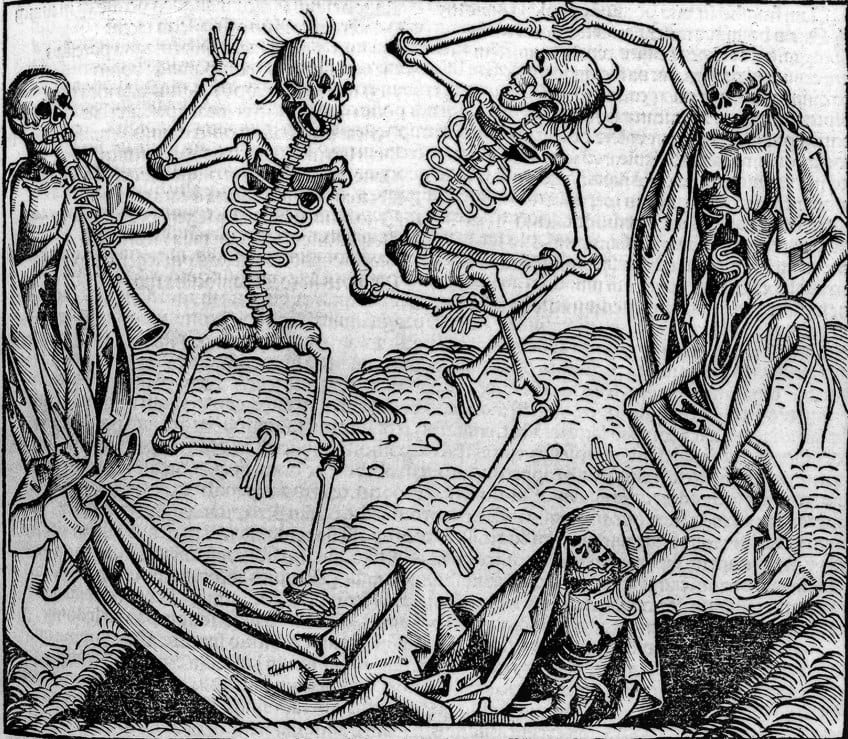
What Influenced The Triumph of Death?
It is also believed The Triumph of Death by Pieter Bruegel the Elder was influenced by the Italian rendition of The Triumph of Death (c. 1440-1445), which is a fresco from the Palazzo Sclafani in Palermo, Italy, which is now in the Palazzo Abatellis in Palermo, Italy.
It has been dubbed as a “mysterious” painting with several artists attributed to it, but who exactly is still debated.
The central figure in the fresco is a large, emaciated horse ridden by a skeleton, which is possibly Death, holding a large bow and shooting an arrow. The surrounding figures are all from varying social classes. We also see the central figure on the horse and people from all walks of life in Bruegel the Elder’s depiction.
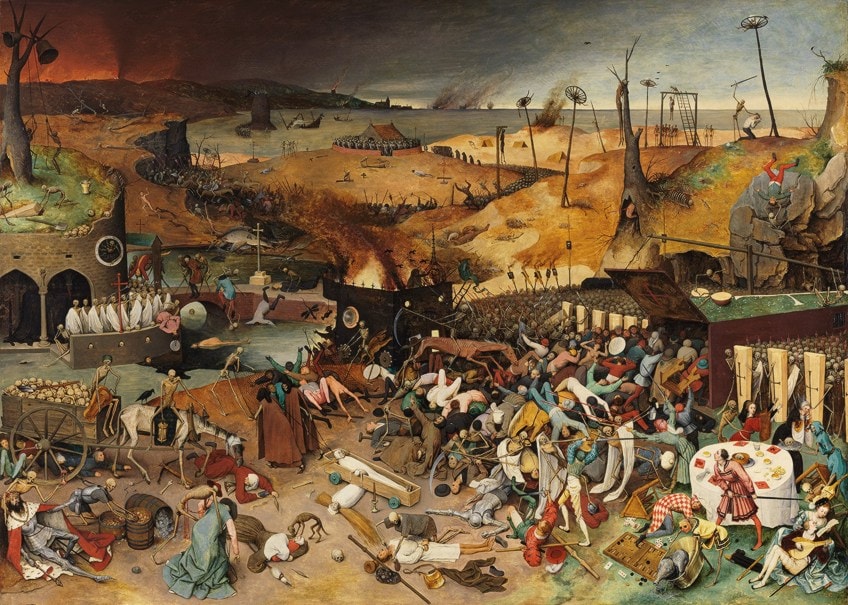
However, any exploration of Pieter Bruegel the Elder’s artwork cannot go without mentioning Hieronymus Bosch, who significantly influenced the way Pieter Bruegel the Elder painted and composed his subject matter.
Hieronymus Bosch was a Dutch painter, active during the 1400s and early 1500s. He has been described as the “earliest”, the “first”, and “predecessor” of Surrealism, portraying subject matter fit for dreams and often the grotesque.
The Garden of Earthly Delights (c. 1490-1515) is one of his famous artworks and an example of his fantastical rendering of figures and otherworldly objects all set within a narrative suggestive of the Biblical Adam and Eve and Hell, as well as themes around creation, temptation, sin, and judgment.

The Triumph of Death was painted over 50 years after Bosch died in 1516 and Pieter Bruegel the Elder would have had access to the former artist’s paintings from various sources. Reportedly, there were also numerous copies of Bosch’s artworks. In the art historian Joseph Leo Koerner’s publication Bosch & Bruegel: From Enemy Painting to Everyday Life (2016), he looks at the two artist’s approaches to art and genre painting and how Bruegel the Elder’s art eventually developed beyond the themes that Bosch represented.
Koerner referred to the latter as “enemy painting” due to the depictions of good and evil; God and the Devil, and notably the Devil as the “enemy”. Bruegel the Elder depicted everyday scenes and people with a large amount being peasants, and without the “enemy” that was so related to Bosch’s depictions.
However, both artists personified aspects of human nature and the various qualities related to it, as well as the “mundane” of life. Some famous examples by Bruegel the Elder include The Fight Between Carnival and Lent (1559) and The Netherlandish Proverbs (1559), both of which depict the idiosyncrasies of human nature. The Wedding Dance (1566) also depicted peasants in celebration and typical everyday events of life.
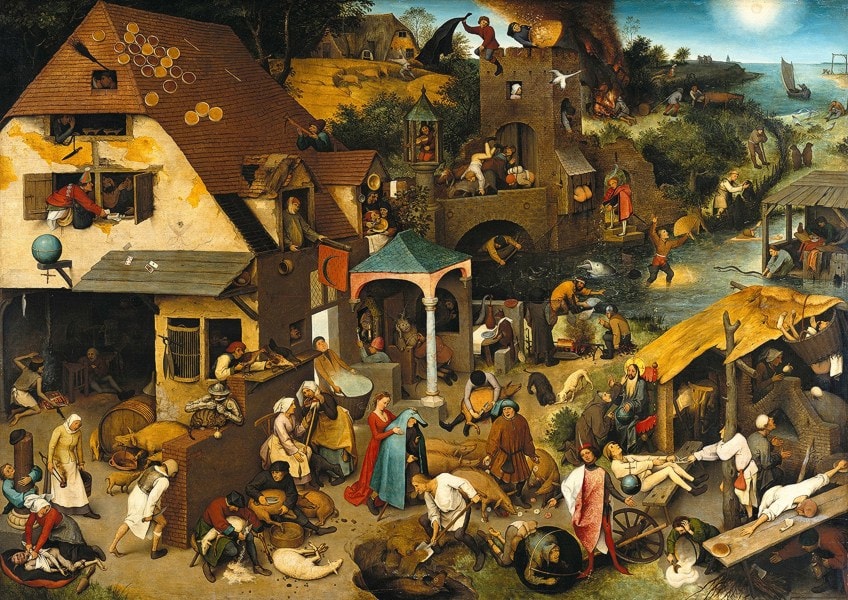
Although there is more complexity to Koerner’s theories, the key idea here is that Bruegel the Elder’s art has been closely correlated with Hieronymus Bosch’s, in concepts and ideas as well as the famous panoramic views, attention to detail, and jam-packed compositional spaces.
An interesting fact is that Pieter Bruegel the Elder’s “The Triumph of Death” and Hieronymus Bosch’s “The Garden of Earthly Delights” are housed in the Museo Nacional del Prado, Madrid in Spain, both in adjoining rooms.
Formal Analysis: A Brief Compositional Overview
The Triumph of Death by Pieter Bruegel the Elder is a complex scene, and without an understanding of the underlying themes you might feel lost like one of the poor humans in the crowd of skeletons. Below, we will look at the composition in greater detail in terms of subject matter and formal art elements and principles.
Subject Matter: Visual Description
The Triumph of Death painting depicts a vast, almost bird’s eye view, an apocalyptic landscape where there are burning fires, black plumes of smoke, bones, and bodies, and a natural environment overturned into chaos. The prevailing feeling is suffering, destruction, and merciless murder.
You might wonder where to start, so let us look at the painting in thirds, starting with the foreground, which is filled with the figures of skeletons, humans, and animals, as well as all sorts of paraphernalia from the everyday world.
Some of these include candlesticks, coffins, barrels of coins, a horse and wagon driven by a skeleton, musical instruments, games like cards and backgammon, various items of clothing, weapons, and more. To the left is what appears to be a building, possibly a church, with a small area of water around it. Here, we also see fish out of the water busy dying. Some of the fish are depicted as larger than life.
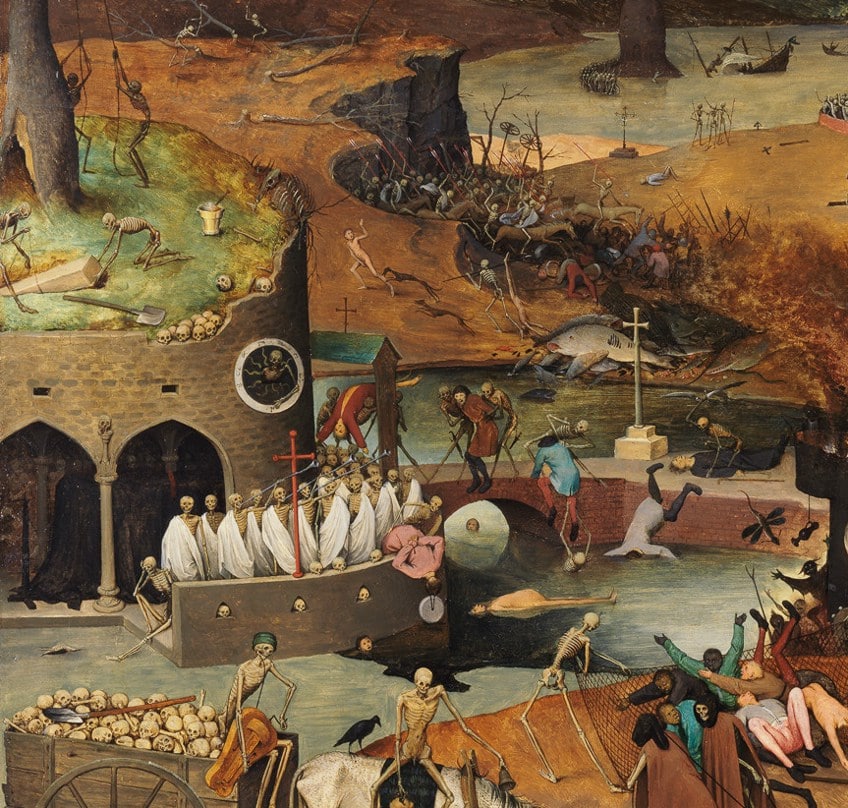
Towards the middleground, which depicts an arid and earthy terrain with small hills, are more figures scattered throughout. Some are solitary and already dead, some are being chased or killed by skeletons, and others are in a large group to the left.
The far background is composed of the seashore with more hills to the left, possibly connecting to the hills in the middleground.
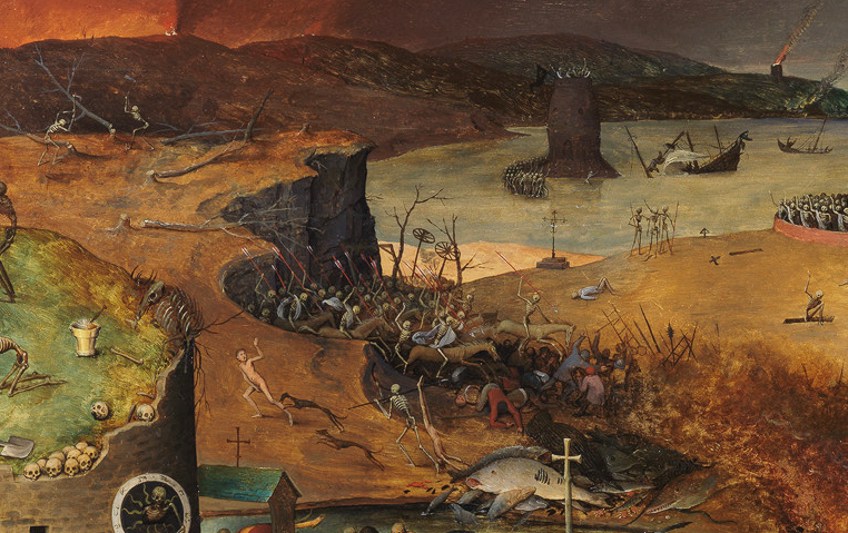
This opens into the vast ocean in the distance where there are several burning ships and what appears to be a church and buildings on the far side of the embankments to the left where, further up the hill, there is a burning building.
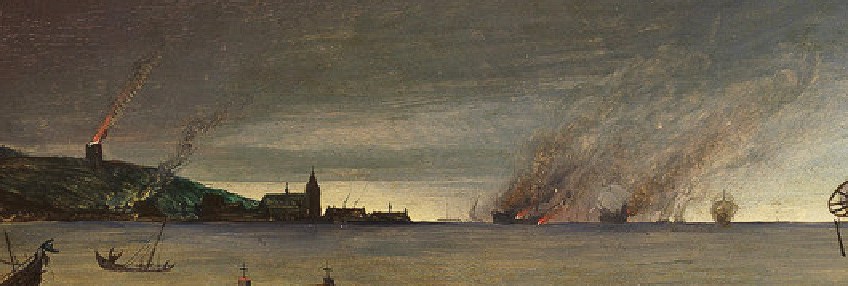
No one is standing still within this deathly vista, except for the dead bodies strewn or hanged here and there. In the lower-left corner is what appears to be a king lying against a skeleton behind him, who is holding up an hourglass in his left hand as if signaling that it is the king’s time to die.
The king is also reaching out his left arm to the barrel of golden coins where another skeleton wearing a suit of armor is grabbing a handful of coins.
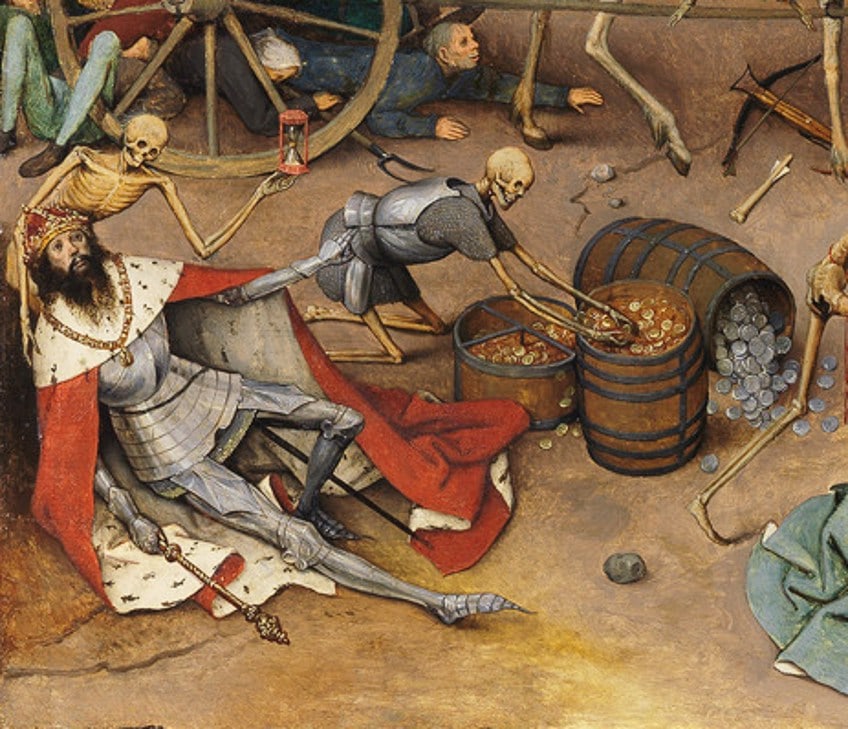
Near the middle foreground is an emaciated dog busy eating at a dead baby. Two skeletons pull at a coffin with a corpse inside and what appears to be the corpse of a child hanging out of it, and another dead body lies underneath the coffin.
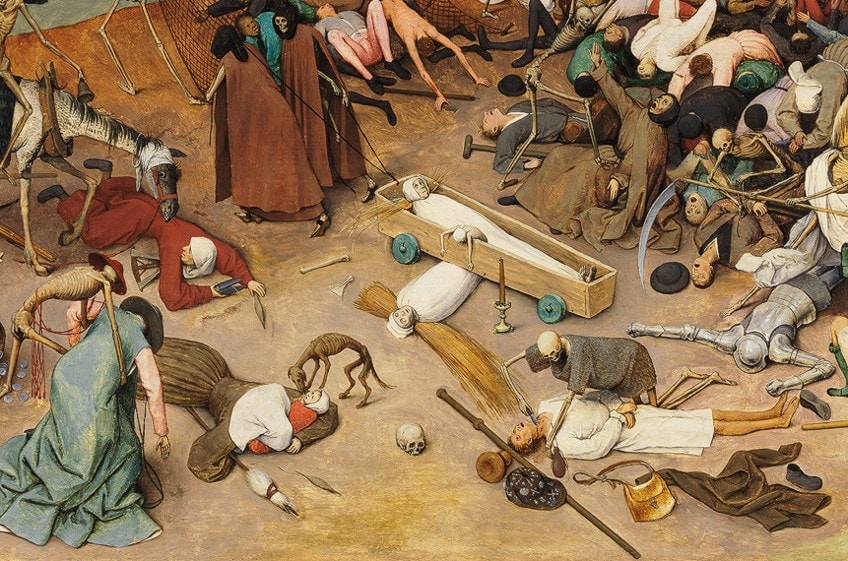
In the lower right corner is a couple, the man is playing the lute and the woman is holding a book, possibly a hymn book, and singing. Behind the woman, a skeleton plays the violin, and they seem unaware of its looming presence. Next to the musical couple is a round table with several bread rolls on it and a skull in a basket in the center.
A skeleton is seen carrying a plate with a skull and two bones on it, as if serving it to the woman in front of it, who appears aghast in terror.

An Army of Skeletons
In the center of the foreground is an emaciated horse with a skeleton riding it and holding a large scythe as if it is the grim reaper, busy swinging it at a mass of terrified people in front of it. Furthermore, the skeleton appears to be herding the people into a large rectangular container, as if leading them to their final fate.
He has also been described as “death” himself leading his army.

On either side of the container (or possibly larger-than-life coffin) are troops of skeletons, standing at the ready as if they are at war; the skeletons in front are holding what appears to be large coffin tops with a cross sign on them.
This possibly alludes to the crusader shield.
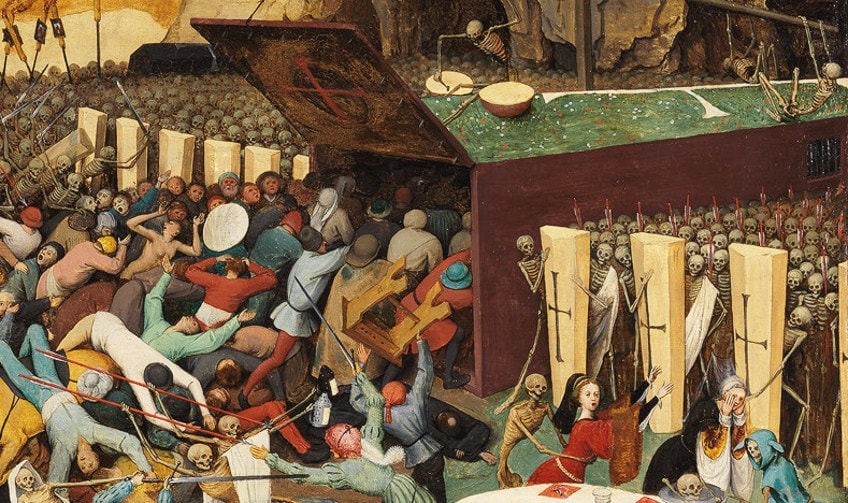
There are also troops of skeletons in the background, on a small hill and round enclosure, as well as a large procession of troops in a trench to the right, who also appear to be going head-on in the battle against a group of people.
Scattered throughout the composition are groups of skeletons, all part of this deathly army that has come to destroy all life and usher the living to their death. There are seemingly countless scenes in “The Triumph of Death” painting.
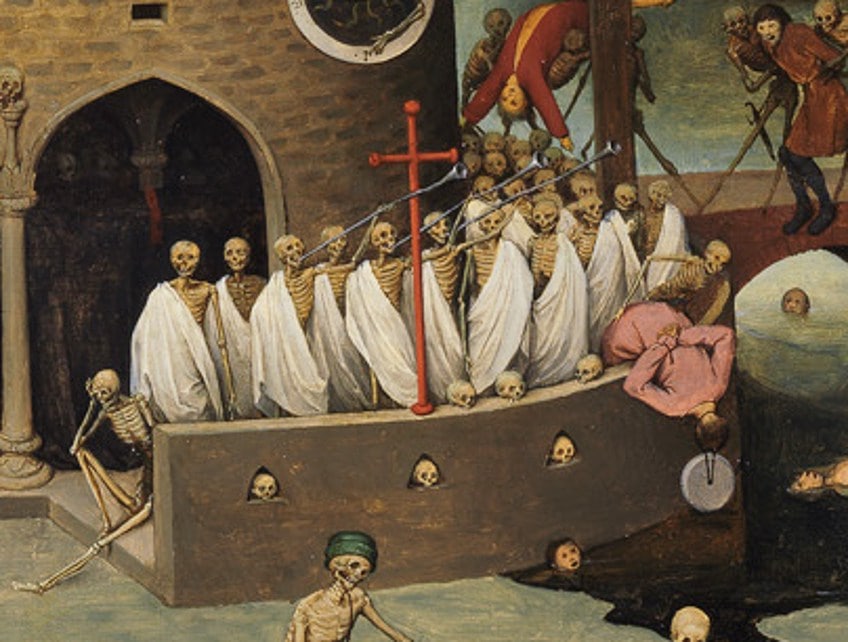
Some of the skeletons are also wearing items of clothing and while they are enacting “mundane” tasks some are in the act of killing people, giving them relatable yet terrifying demeanors.
Furthermore, these human-like activities add a sort of dark humor and almost satire to how they are portrayed.
For example, the skeleton on the wagon wearing a black hat, the skeleton wearing a mask to the lower right corner, or the skeleton sitting with its right hand resting on its skull and elbow resting on its knee, as if it is in deep contemplation, near the skeletons that are blowing trumpets to the left middleground.

Color
The Triumph of Death by Pieter Bruegel the Elder is described as an overall “reddish-brown”, which adds to the intensity of what is taking place in the composition as if it is a hellish landscape. There are darker areas of color, for example, the blackened building in the center of the composition, as well as the smoke in the upper left corner.
However, there is a harmony of color due to the artist’s utilization of similar color values.

Texture
Pieter Bruegel the Elder painted The Triumph of Death thoroughly detailed, and inevitably there are numerous implied textures throughout the composition, which portrays the subject matter in as much realism as possible even if the themes explored are otherworldly.
Furthermore, the artist utilized different types of brushwork to create different textures, such as the more scumbled brushwork to indicate the smoke and the more thinned and long brushstrokes to indicate the areas of water.

Line
There is a dominance of diagonal lines in The Triumph of Death by Pieter Bruegel the Elder, which creates movement and rhythm and heightens the dramatic effect of the subject matter. There is a crisscrossing of lines created by the strewn and stranded bodies in the foreground, as well as the various implements and weapons scattered about. Towards the background, there are vertical lines created by the tree stumps protruding upwards, as well as the erected beams where we see figures hanging.
The diagonal lines are contrasted with the curved lines created from the sloping hills and the troops arranged in circular patterns.
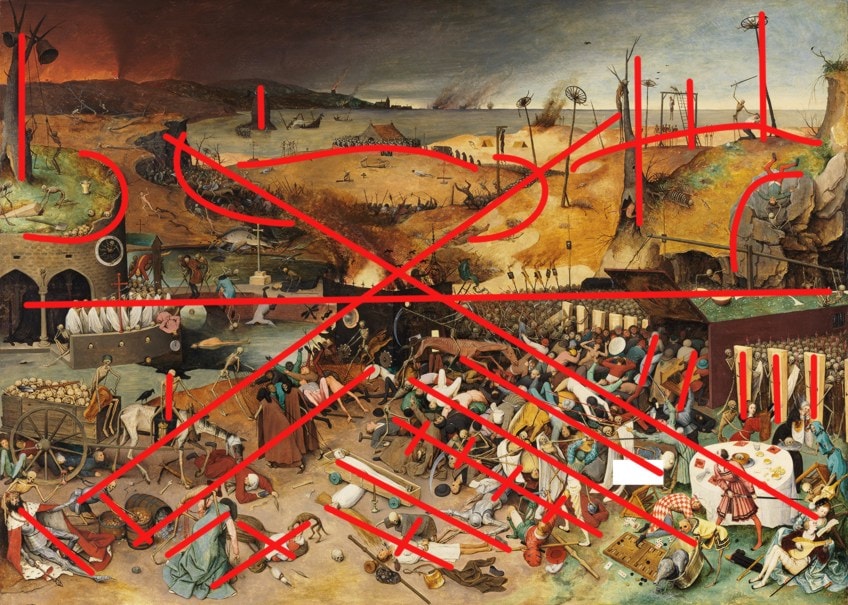
Space
The space in The Triumph of Death by Pieter Bruegel the Elder is open and vast, a landscape scene, which appears as if from an aerial perspective. Furthermore, the artist filled most of the compositional space, around two-thirds, with unending action and movement.
Shape and Form
The entire composition of The Triumph of Death painting comes alive through the arrangement of different types of lines, which become multitudes of shapes and forms. Some of the more dominant shapes are organic, in other words, following the forms of nature, such as the human bodies, the natural landscape, and sloping hills.
The various buildings and structures are more geometric in their shapes, which creates a bit of contrast.
The groupings of skeletons, some to the left and the army to the right, create repetition and a patterned effect, which also contrasts with the overall chaos created by the different shapes and forms of the humans, animals, skeletons, and paraphernalia.
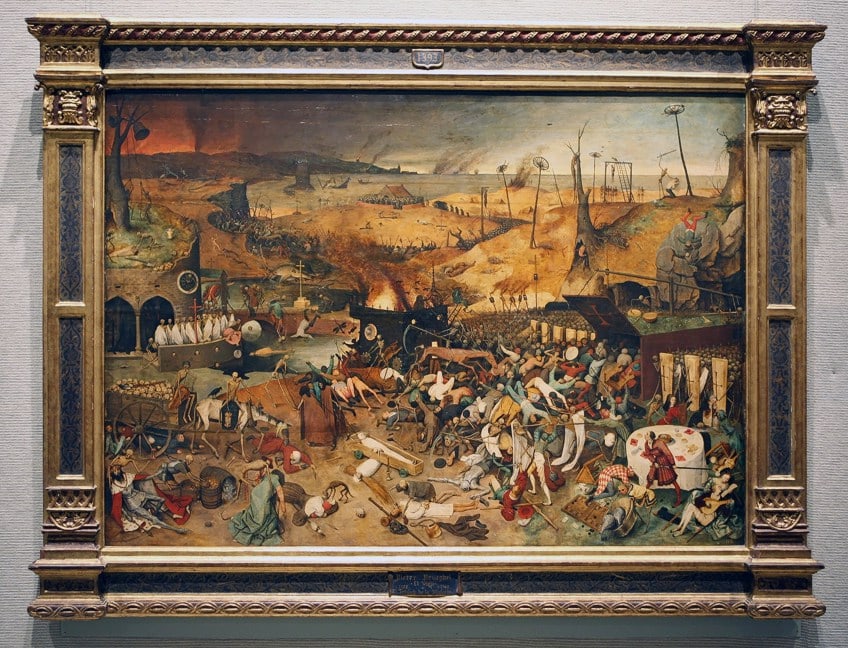
The Unabashed Bruegel
The Triumph of Death by Pieter Bruegel the Elder underwent an extensive restoration in May 2018, which was sponsored by the Fundacion Iberdrola España. The painting was reportedly restored in the past, and it was “dark and opaque, with a cloudy appearance” according to the restorers, who managed to reveal some of the original color and details of the subject matter.
Pieter Bruegel the Elder did not seem to veer on the side of light-heartedness when he created “The Triumph of Death” painting. It is unnerving at best, reminding us, the viewers, of the rawness and inhumanity of death through the visual personification of it. We might find ourselves chuckling in awe and possibly shock at some of the caricatures presented and parodied, but we are quickly sobered by them too. The sheer artistic mastery with which Pieter Bruegel the Elder executed “The Triumph of Death” almost softens the blow of his unabashed depiction of death and its role as part of life. The painting reminded everyone about mortality and the follies of life.
Take a look at our The Triumph of Death painting webstory here!
Frequently Asked Questions
Where Is The Triumph of Death Painting?
The Triumph of Death (c. 1562) by Pieter Bruegel the Elder has been housed at the Museo Nacional del Prado, Madrid in Spain since 1827. Before that, it was in the collection of various nobilities and royalties.
Who Painted The Triumph of Death?
The Triumph of Death (c. 1562) was painted by Pieter Bruegel the Elder, who was a Northern Renaissance artist, namely from the Netherlands. He was well known for his genre paintings, which included a focus on peasants and landscapes.
What Does The Triumph of Death Mean?
The Triumph of Death (c. 1562) oil painting by the Northern Renaissance artist Pieter Bruegel the Elder explored themes around death and was most probably influenced by the Black Plague during the Medieval times.
What Are the Themes in The Triumph of Death?
The Triumph of Death (c. 1562) by Pieter Bruegel the Elder explored the themes around the Danse Macabre (Dance of Death), which was a common genre in the visual and literary arts, as well as music. It was a reminder to people about death.
Why Was He Called Pieter Bruegel the Elder?
Pieter Bruegel the Elder had a son who was also named Pieter Bruegel, who was also a well-known painter. He was named Pieter Bruegel the Elder and his son Pieter Bruegel the Younger so that there would not be confusion between the two artists.
Alicia du Plessis is a multidisciplinary writer. She completed her Bachelor of Arts degree, majoring in Art History and Classical Civilization, as well as two Honors, namely, in Art History and Education and Development, at the University of KwaZulu-Natal, South Africa. For her main Honors project in Art History, she explored perceptions of the San Bushmen’s identity and the concept of the “Other”. She has also looked at the use of photography in art and how it has been used to portray people’s lives.
Alicia’s other areas of interest in Art History include the process of writing about Art History and how to analyze paintings. Some of her favorite art movements include Impressionism and German Expressionism. She is yet to complete her Masters in Art History (she would like to do this abroad in Europe) having given it some time to first develop more professional experience with the interest to one day lecture it too.
Alicia has been working for artincontext.com since 2021 as an author and art history expert. She has specialized in painting analysis and is covering most of our painting analysis.
Learn more about Alicia du Plessis and the Art in Context Team.
Cite this Article
Alicia, du Plessis, ““The Triumph of Death” by Pieter Bruegel the Elder – Art Analysis.” Art in Context. September 16, 2022. URL: https://artincontext.org/the-triumph-of-death-by-pieter-bruegel-the-elder/
du Plessis, A. (2022, 16 September). “The Triumph of Death” by Pieter Bruegel the Elder – Art Analysis. Art in Context. https://artincontext.org/the-triumph-of-death-by-pieter-bruegel-the-elder/
du Plessis, Alicia. ““The Triumph of Death” by Pieter Bruegel the Elder – Art Analysis.” Art in Context, September 16, 2022. https://artincontext.org/the-triumph-of-death-by-pieter-bruegel-the-elder/.


